One of my regular readers, Oscar, sent me an email yesterday with the idea of starting to cover some of the ingredients, fresh and packaged, that we have in “ethnic” markets in particular here that both locals and foreigners may not be familiar with, especially if they’re not part of their own culture. I’ve done a few ingredient posts before – zapallitos redondos, those round green squashes that you see everywhere in vegetable markets was one of the first. But that was back in July of 2005, and I knew next to nothing about them, so I’m going to put that on the list coming up. I’ve also, in the same vein, way back, and in need of updating, covered some Peruvian herbs like huacatay and quirquiña, and some of the Andean root vegetables like papalisas and ocas, and others where I’ve just posted photos of market hauls. So – also on the docket. By the way, this is the kind of idea I’m looking for in thinking about the future of the blog!
Today, however, I thought I’d start off with a look at something near and dear to my own cooking, some of the Peruvian chilies that are most commonly available in either verdulerias or from the Bolivian women who sell stuff on the streets. In Peru itself there are roughly 300 different varieties of chilies, but most of them are not available here.
Ají limos. First off, folk in most of Spanish speaking South America refer to what most English speaking people would likely call “chilies”, as ajies. In Mexico and Central America they tend to be called chilis. “Ají” is a bit more generic, and also includes things like Italian frying peppers, and for many people, bell peppers (though at least here in BA those are usually either called morrones or pimentons). You can pretty much count on any of the Bolivian ladies, and many local vegetable stands to carry these, often they just refer to them as picante, or “spicy”. These relatively small chilies, usually about 1½-2 inches in length, are usually medium hot, about on par with a tabasco or cayenne pepper. A common question is if the color (green, red, sometimes yellow) makes a difference in the heat level – and just on personal observation, I’d say no, though there are definitely subtle differences in their flavors. They’re probably the most common Peruvian pepper used in garnishes, tossed with ceviches, and, in making the common hot sauce served automatically on the table of most home cooking Peruvian restaurants. They’re usually pretty inexpensive – a good sized handful of them for 10-15 pesos – less than a dollar.
The hot sauce is really simple – a handful of these chilies with the stems removed, an egg yolk, a splash of vinegar – blended together until smooth, sometimes strained, most times not, and then salt added to taste. Some people also add oil, but that’s less common from what I’ve seen, and, not surprisingly, results in a more mayonnaise-like consistency.
Rocotos. Interestingly, “rocotos” to the Peruvians and “locotos” to the Bolivians – which at least to me is counter-intuitive since Peru has a much bigger Asian community influence than Bolivia, and that’s where the L as a substitute for the R comes up frequently. I’m sure some linguist could explain why. Rocotos also have the unusual distinction of being the only chili out there with naturally occurring jet black or very dark brown seeds when ripe (and, if you see the plant, they have “hairy” leaves). Rocotos are wildly variable in their spiciness – they can be as mild as Italian cherry peppers and as potent as a habanero. There’s not even a way to guess from a batch of them. We’ve bought a half dozen and had them cover the whole range. In shape, they’re generally sort of like a wrinkled small apple, roughly 2″ tall, and varying in color from green to red to yellow. Depending on the season, these are pretty expensive peppers as local ones go, usually running anywhere from 7-12 pesos apiece.
Often used as simple garnishes – either in slices, julienne, or diced. In the link above about huacatay and quirquiña I give a recipe for Salsa Llawa, a traditional Bolivian condiment, though if you follow the commentary afterwards, there was quite some contention about how it’s made – most traditionally it would be tomato, rocoto, quirquiña and/or huacatay, and salt. We use it in making our Salsa Negra (though that’s mostly because we don’t have habaneros here), as a simple emulsion in olive oil and salt, pureed with yogurt, and as part of the base of numerous of our spicier soups and stews.
Ají Amarillo. Simply, “yellow pepper”. This is another very commonly used pepper in Peruvian cuisine. Probably it’s most popular uses are blended into the leche de tigre curing liquid for a different take on ceviche, as the heat in the potato base of a causa, and in huancaina sauce, which is also the base sauce for ocopa (huancaina with huacatay blended in for a vibrant green color and vaguely mint flavor), and for the various dishes in the general style of ají de gallina and ají de langostinos that show up regularly in Peruvian restaurants. They range from 3-5″ in length and like rocotos can be a little pricey, anywhere from 5-15 pesos apiece depending on season and size. They’re a vivid yellow-orange in color. Their heat level is about the equivalent of tabasco or cayenne chilies, but can edge up a bit hotter too. I’ve already written a step-by-step process for making the latter dishes mentioned above.
For an ají amarillo curing liquid for ceviche, our version is 1 ají amarillo (seeds and all), juice of six limes, juice of three oranges, 3 Tb good olive oil – puree together and season with salt to taste – it’ll take almost a full tablespoon of salt to balance this. We like the texture to be a creamy emulsion, so at this point we blend in 1/8 tsp of xanthan gum and blend it for about a full minute to thicken the texture, then strain it. We use this to cure stronger flavored fish, one of our favorites is the palometa, a local species in the same family as pompano and pomfret. This would also work for a ceviche of tuna, bluefish, mackerel, anchovy, and other similar oily and strong flavored fishes. We garnish it with chives, basil, red onion, and sweet pickled orange peel.
Ají mirasól and Ají panca. These two are so common in Peruvian cooking that no kitchen would be without them. They’re both dried chilies, and every kitchen I’ve ever been in had bags of them. The former, the mirasól, or “sun look”, are simply dried ají amarillos, and the flavor and use pretty much match, though the dried ones are often used to flavor broths and soups. The latter, the panca, is a dried red chili (and the only place I’ve ever seen them fresh is in Mexico, not in Peru). It’s much milder than the the yellow pepper (about the same as a poblano or pasilla), and has a slightly fruity and smoky flavor to it. It’s used in a wide variety of sauces, stews, and soups, it’s the major component of the marinade for anticuchos. Both of these are also available in puree/paste form in packets in many of the local vegetable shops, or jars in Barrio Chino (or you can make your own by rehydrating and then pureeing them), and also in powdered form, respectively called ají amarillo en polvo and ají rojo en polvo – yellow chili in powder, red chili in powder. In their whole form they run about 400-450 pesos a kilo, but a kilo of these is somewhere between 125-150 chilies, and you can buy them in packages of about 125 grams, roughly 15-20 chilies.
One of my favorite slow cooked dishes is Pachamanca, a braised dish of beef, pork, and/or chicken, along with sweet potatoes and corn, traditionally cooked in a sealed earthen oven, with the braising liquid made from chicha de jora, a corn beer (we use dark beer with a splash of vinegar added when we can’t get chicha de jora), garlic, cumin, red onion, ají panca, cilantro, and huacatay. In our version we then strain off the liquid and reduce it down to a thick glaze, season with salt, and finish it with a little cold butter to give it a glossy shine.
So, this was my little start on ingredients. I don’t know if it was what Oscar had in mind, but I’ll look around for other things in the markets to cover. And, taking suggestions!
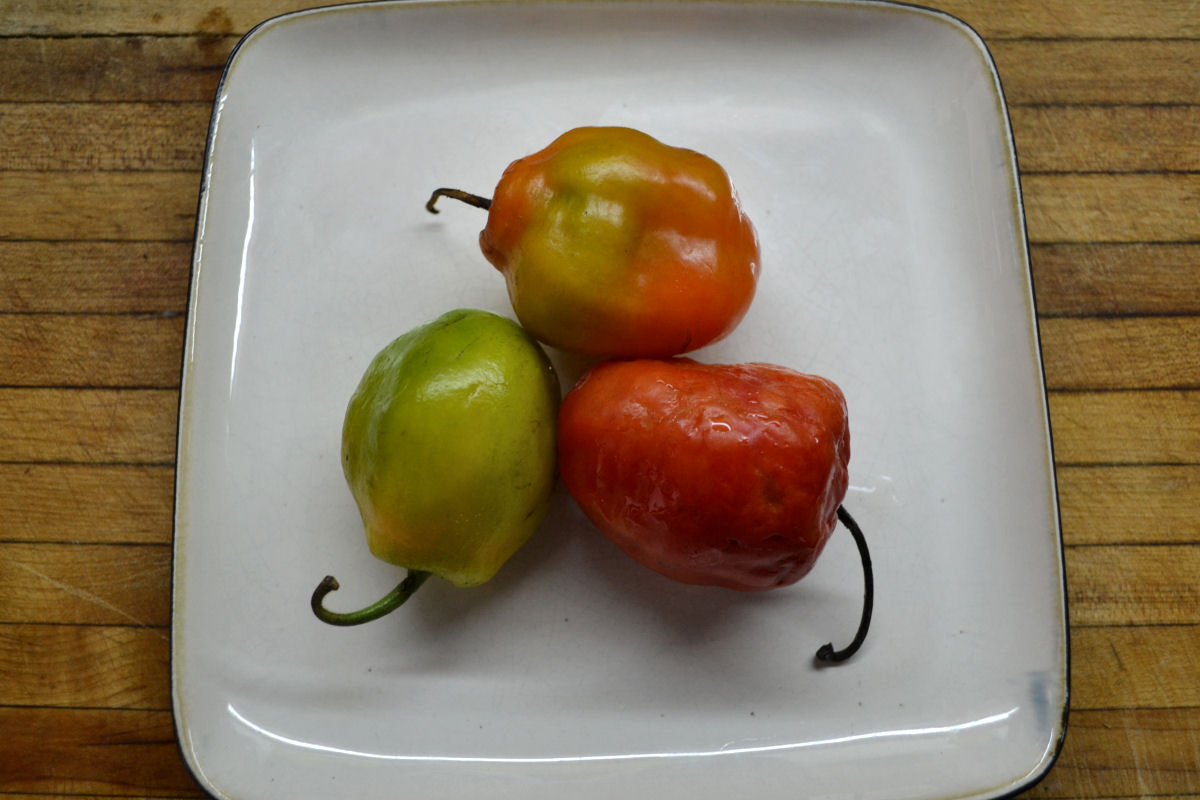
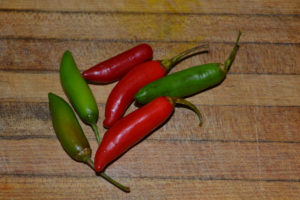
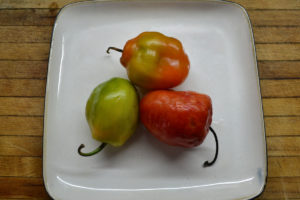
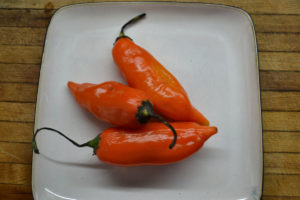
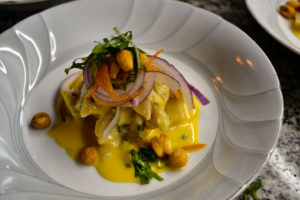
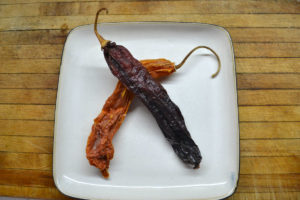
Yep, I love this one! Useful and full of ideas. Exactly what I had in mind and masterfully executed!
“Rocoto” comes from the Quechua language, while “locoto” comes from the Aymara (mainly spoken in Bolivia). Both have coexisted in the same territory for centuries and are cross-linked, but retaining their particular characteristics. As an interesting aside, see for example http://www.nytimes.com/1984/12/01/world/old-andes-language-finds-niche-in-computer-age.html
Diced tomatoes, soft goat cheese, quirquiña, black pepper and olive oil and an acidic touch make a very interesting salad.
I’d like very much an exploration of the Korean supermarkets in Flores and an exegesis of those mysterious packages on the Arribeños shelves.
Thanks a lot!
I wondered if perhaps the Quechua/Aymara dichotomy was what was behind the difference in the language but didn’t find anything on it online. And, as both languages have both “L” and “R” sounds, I wasn’t too sure that that would be the answer. Thanks!
FYI
https://books.google.com.ar/books?id=dA5mkzfmATEC&pg=PA21&lpg=PA21&dq=lucutu+locoto+aymara&source=bl&ots=wbQrGjyXNu&sig=oMNjX9ewkB7x-U-oi1BgRKs5rOI&hl=en&sa=X&redir_esc=y#v=onepage&q=lucutu%20locoto%20aymara&f=false
[…] great choice, 60ml (¼ cup) of good, spicy olive oil, two garlic cloves, two green chilies (we use ají limos), and roughly ½ tsp of salt (you may need a little more, depending on how salty your cheese […]
This is very helpful! Thanks Dan.
I love the video and pictures. Now I am missing South America. I had such a great time traveling there. Please sign me up if you do more.
Oh, there are definitely more coming (and there are more already here, if you look in the column to the right, there’s a whole page with different ingredient explorations).
[…] chopped mixture of octopus, prawn. The sauce is, ostensibly, a “panka miso”, though aji panka is a dark reddish brown chili, not a bright yellow one (as I discussed in the linked post), so I […]
[…] – A classic dish of sauteed olluquos, a.k.a. papalisas – flavored with ají panka, garlic, and oregano, and here with strips of chicken. While not as good as the one Henry makes at […]
[…] in front at the left… Small white potatoes, puree of rehydrated mirasol chilies, huacatay, garlic, onion, fresh homemade cheese (not by us, by someone out at the Liniers markets), […]
[…] it’s unlikely they found poblano chilies here, so probably made with something local like aji panka. Despite the common wisdom that mole is a chocolate based sauce, few of the many moles out there […]
[…] a couple of cloves of garlic. And, rehydrated two red ají pancas and 1 yellow aji mirasol, the dried chilies we’ve talked about many a time, pureed and added to the soup. Then it was just simmering away until the meat was […]